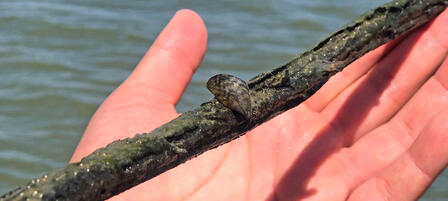Zebra Mussels Found in Lyon State Fishing Lake

TOPEKA- The Kansas Department of Wildlife, Parks and Tourism (KDWPT) has confirmed the presence of invasive zebra mussels in Lyon State Fishing Lake in Lyon County. Routine samples collected by KDWPT Aquatic Nuisance Species staff to detect zebra mussels were found to contain zebra mussel larvae (also called veligers). Upon finding the veligers, staff returned to the lake and located an established population of adult zebra mussels. Similar sampling is conducted by KDWPT at more than 100 waterbodies across the state.
The 135-acre lake is located 12 miles north and two miles east of Emporia on Rd 270. Lyon State Fishing Lake is owned and operated by KDWPT. The lake and surrounding wildlife area are popular destinations for fishing, hunting, hiking, and a variety of other outdoor-related activities.
While the zebra mussel population is currently small, there is no known method to completely rid a lake of this invasive species. The zebra mussels were likely introduced by “hitchhiking” with un-suspecting lake-goers. Adults are able to attach to boats or other equipment and the microscopic zebra mussel veligers may be present in any water originating from an infested lake or stream. Densities as high as 1,000 veligers per gallon have been recorded in Kansas waters.
“This is the first new population of zebra mussels found in the state in 18 months, which is the longest period of time between new lake infestations since 2006. While it is unfortunate that zebra mussels have been spread to a new lake, I remain hopeful that these occurrences will be less frequent as more people have become aware of zebra mussels, their impacts, and how to prevent moving them,” said Chris Steffen, aquatic nuisance species coordinator for KDWPT.
Lyon State Fishing Lake will be added to the list of ANS-designated waters in Kansas, and notices will be posted at various locations around the waterbody. Live fish may not be transported from ANS-designated waters. The sharp-shelled zebra mussels attach to solid objects, so lake-goers should be careful when handling mussel-encrusted objects and when grabbing an underwater object when they can’t see what their hands may be grasping. Visitors should protect their feet when walking on underwater or shoreline rocks.
Zebra mussels are just one of the non-native aquatic species that threaten our waters and native wildlife. After using any body of water, people must remember to follow regulations and precautions that will prevent their spread:
- Clean, drain and dry boats and equipment between uses
- Use wild-caught bait only in the lake or pool where it was caught
- Do not move live fish from waters infested with zebra mussels or other aquatic nuisance species
- Drain livewells and bilges and remove drain plugs from all vessels prior to transport from any Kansas water on a public highway.
For more information about aquatic nuisance species in Kansas, report a possible ANS, or see a list of ANS-designated waters, visit ProtectKSWaters.org.
ABOUT ZEBRA MUSSELS
Zebra mussels are dime-sized mollusks with striped, sharp-edged, two-part shells. They can produce huge populations in a short time and do not require a host fish to reproduce. A large female zebra mussel can produce 1 million eggs, and then fertilized eggs develop into microscopic veligers that are invisible to the naked eye. Veligers drift in the water for at least two weeks before they settle out as young mussels which quickly grow to adult size and reproduce within a few months.
After settling, zebra mussels develop byssal threads that attach their shells to submerged hard surfaces such as rocks, piers, and flooded timber. They also attach to pipes, water intake structures, boat hulls, propellers, and submerged parts of outboard motors. As populations increase, they can clog intake pipes and prevent water treatment and electrical generating plants from drawing water. In 2012, two Kansas communities, Council Grove and Osage City, experienced temporary water shortages from zebra mussel infestations before water intake structures could be cleaned up. Removing large numbers of zebra mussels to ensure adequate water flow can be labor-intensive and costly.
Zebra mussels are native to the Black and Caspian seas of western Asia and eastern Europe and were spread around the world in the ballast water of cargo ships. They were discovered in Lake St. Clair and the Detroit River in 1988 and quickly spread throughout the Great Lakes and other rivers including the Mississippi, Illinois, Ohio, Tennessee, Arkansas and Hudson. They were first discovered in Kansas in 2003 at El Dorado Reservoir. Despite public education efforts to alert boaters about the dangers of zebra mussels and how to prevent spreading them, the species continues to show up in new lakes every year. Moving water in boats and bait buckets has been identified as a likely vector.
For information about Lyon State Fishing Lake, visit KSOutdoors.com, click on Fishing, then Where to Fish and select the Northeast region.
-30-







